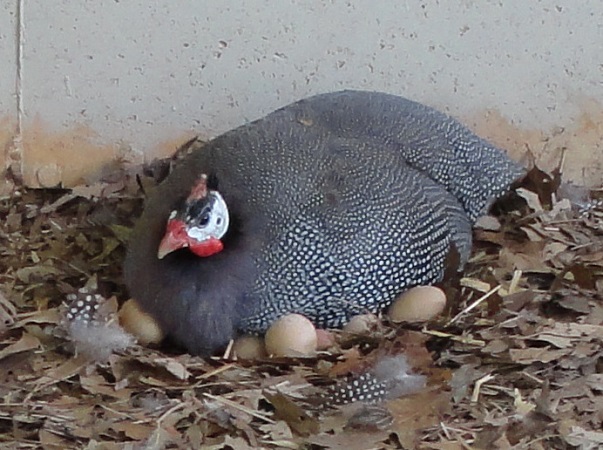

Farmer need to build and expand sizes of their guinea fowl flocks by incubating eggs. There are two main methods; You may use natural and artificial incubation. For small scale producers natural incubation is recommended. This is done by allowing chicken or turkey to sit on the eggs. This is recommended because guinea hens are known to leave the nest after a few keets have hatched or sometimes laying for too long. About 12 - 15 eggs can be set under a broody guinea hen while 18 to 20 may be set under a large chicken hen. The eggs will be hatched after 26 to 30 days of incubation.
Guinea-fowl-incubation
It is important to clean the eggs for hatching before they are set under the brooder bird using a mild disinfectant. Use of clean material for the brooding area is also recommended.
Under large commercial operation testing breeder birds for salmonella pullorum is essential to eliminate reactors.
Several small scale farmers can join hands to buy and use a community management brooder to artificially hatch keets, Brooders for local chicken is adequate.
Sexing of keets is difficult to one who is not trained to do so. A Simple way of sexing is to wait until the birds a more grown up at the age of 6-8 weeks. By listening to the sound they make one can distinguish the male from female. Females make two syllable calls for example bukwheat, bucwheat or putrock, putrock or quatrack quatrack.
Also by looking at their helmet and wattles. Helmets and wattles of a male are much larger than those of a female.
Guinea-fowl-incubation
It is important to clean the eggs for hatching before they are set under the brooder bird using a mild disinfectant. Use of clean material for the brooding area is also recommended.
Under large commercial operation testing breeder birds for salmonella pullorum is essential to eliminate reactors.
Several small scale farmers can join hands to buy and use a community management brooder to artificially hatch keets, Brooders for local chicken is adequate.
Sexing of keets is difficult to one who is not trained to do so. A Simple way of sexing is to wait until the birds a more grown up at the age of 6-8 weeks. By listening to the sound they make one can distinguish the male from female. Females make two syllable calls for example bukwheat, bucwheat or putrock, putrock or quatrack quatrack.
Also by looking at their helmet and wattles. Helmets and wattles of a male are much larger than those of a female.
 Contact Jaguza Support
Contact Jaguza Support